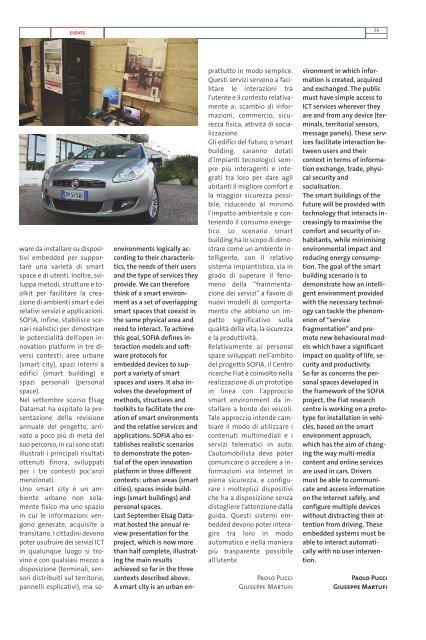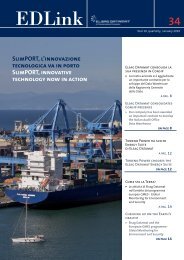ED Link n. 38 - Elsagdatamat.eu
ED Link n. 38 - Elsagdatamat.eu
ED Link n. 38 - Elsagdatamat.eu
You also want an ePaper? Increase the reach of your titles
YUMPU automatically turns print PDFs into web optimized ePapers that Google loves.
EVENTS<br />
ware da installare su dispositivi<br />
embedded per supportare<br />
una varietà di smart<br />
space e di utenti. Inoltre, sviluppa<br />
metodi, strutture e toolkit<br />
per facilitare la creazione<br />
di ambienti smart e dei<br />
relativi servizi e applicazioni.<br />
SOFIA, infine, stabilisce scenari<br />
realistici per dimostrare<br />
le potenzialità dell’open innovation<br />
platform in tre diversi<br />
contesti: aree urbane<br />
(smart city), spazi interni a<br />
edifici (smart building) e<br />
spazi personali (personal<br />
space).<br />
Nel settembre scorso Elsag<br />
Datamat ha ospitato la presentazione<br />
della revisione<br />
annuale del progetto, arrivato<br />
a poco più di metà del<br />
suo percorso, in cui sono stati<br />
illustrati i principali risultati<br />
ottenuti finora, sviluppati<br />
per i tre contesti poc’anzi<br />
menzionati.<br />
Uno smart city è un ambiente<br />
urbano non solamente<br />
fisico ma uno spazio<br />
in cui le informazioni vengono<br />
generate, acquisite o<br />
transitano. I cittadini devono<br />
poter usufruire dei servizi ICT<br />
in qualunque luogo si trovino<br />
e con qualsiasi mezzo a<br />
disposizione (terminali, sensori<br />
distribuiti sul territorio,<br />
pannelli esplicativi), ma so-<br />
environments logically according<br />
to their characteristics,<br />
the needs of their users<br />
and the type of services they<br />
provide. We can therefore<br />
think of a smart environment<br />
as a set of overlapping<br />
smart spaces that coexist in<br />
the same physical area and<br />
need to interact. To achieve<br />
this goal, SOFIA defines interaction<br />
models and software<br />
protocols for<br />
embedded devices to support<br />
a variety of smart<br />
spaces and users. It also involves<br />
the development of<br />
methods, structures and<br />
toolkits to facilitate the creation<br />
of smart environments<br />
and the relative services and<br />
applications. SOFIA also establishes<br />
realistic scenarios<br />
to demonstrate the potential<br />
of the open innovation<br />
platform in three different<br />
contexts: urban areas (smart<br />
cities), spaces inside buildings<br />
(smart buildings) and<br />
personal spaces.<br />
Last September Elsag Datamat<br />
hosted the annual review<br />
presentation for the<br />
project, which is now more<br />
than half complete, illustrating<br />
the main results<br />
achieved so far in the three<br />
contexts described above.<br />
A smart city is an urban en-<br />
prattutto in modo semplice.<br />
Questi servizi servono a facilitare<br />
le interazioni tra<br />
l’utente e il contesto relativamente<br />
a: scambio di informazioni,<br />
commercio, sicurezza<br />
fisica, attività di socializzazione.<br />
Gli edifici del futuro, o smart<br />
building, saranno dotati<br />
d’impianti tecnologici sempre<br />
più interagenti e integrati<br />
tra loro per dare agli<br />
abitanti il migliore comfort e<br />
la maggior sicurezza possibile,<br />
riducendo al minimo<br />
l’impatto ambientale e contenendo<br />
il consumo energetico.<br />
Lo scenario smart<br />
building ha lo scopo di dimostrare<br />
come un ambiente intelligente,<br />
con il relativo<br />
sistema impiantistico, sia in<br />
grado di superare il fenomeno<br />
della “frammentazione<br />
dei servizi” a favore di<br />
nuovi modelli di comportamento<br />
che abbiano un impatto<br />
significativo sulla<br />
qualità della vita, la sicurezza<br />
e la produttività.<br />
Relativamente ai personal<br />
space sviluppati nell’ambito<br />
del progetto SOFIA, il Centro<br />
ricerche Fiat è coinvolto nella<br />
realizzazione di un prototipo<br />
in linea con l’approccio<br />
smart environment da installare<br />
a bordo dei veicoli.<br />
Tale approccio intende cambiare<br />
il modo di utilizzare i<br />
contenuti multimediali e i<br />
servizi telematici in auto.<br />
L’automobilista deve poter<br />
comunicare o accedere a informazioni<br />
via Internet in<br />
piena sicurezza, e configurare<br />
i molteplici dispositivi<br />
che ha a disposizione senza<br />
distogliere l’attenzione dalla<br />
guida. Questi sistemi embedded<br />
devono poter interagire<br />
tra loro in modo<br />
automatico e nella maniera<br />
più trasparente possibile<br />
all’utente.<br />
Paolo Pucci<br />
Giuseppe Martufi<br />
36<br />
vironment in which information<br />
is created, acquired<br />
and exchanged. The public<br />
must have simple access to<br />
ICT services wherever they<br />
are and from any device (terminals,<br />
territorial sensors,<br />
message panels). These services<br />
facilitate interaction between<br />
users and their<br />
context in terms of information<br />
exchange, trade, physical<br />
security and<br />
socialisation.<br />
The smart buildings of the<br />
future will be provided with<br />
technology that interacts increasingly<br />
to maximise the<br />
comfort and security of inhabitants,<br />
while minimising<br />
environmental impact and<br />
reducing energy consumption.<br />
The goal of the smart<br />
building scenario is to<br />
demonstrate how an intelligent<br />
environment provided<br />
with the necessary technology<br />
can tackle the phenomenon<br />
of “service<br />
fragmentation” and promote<br />
new behavioural models<br />
which have a significant<br />
impact on quality of life, security<br />
and productivity.<br />
So far as concerns the personal<br />
spaces developed in<br />
the framework of the SOFIA<br />
project, the Fiat research<br />
centre is working on a prototype<br />
for installation in vehicles,<br />
based on the smart<br />
environment approach,<br />
which has the aim of changing<br />
the way multi-media<br />
content and online services<br />
are used in cars. Drivers<br />
must be able to communicate<br />
and access information<br />
on the Internet safely, and<br />
configure multiple devices<br />
without distracting their attention<br />
from driving. These<br />
embedded systems must be<br />
able to interact automatically<br />
with no user intervention.<br />
Paolo Pucci<br />
Giuseppe Martufi



